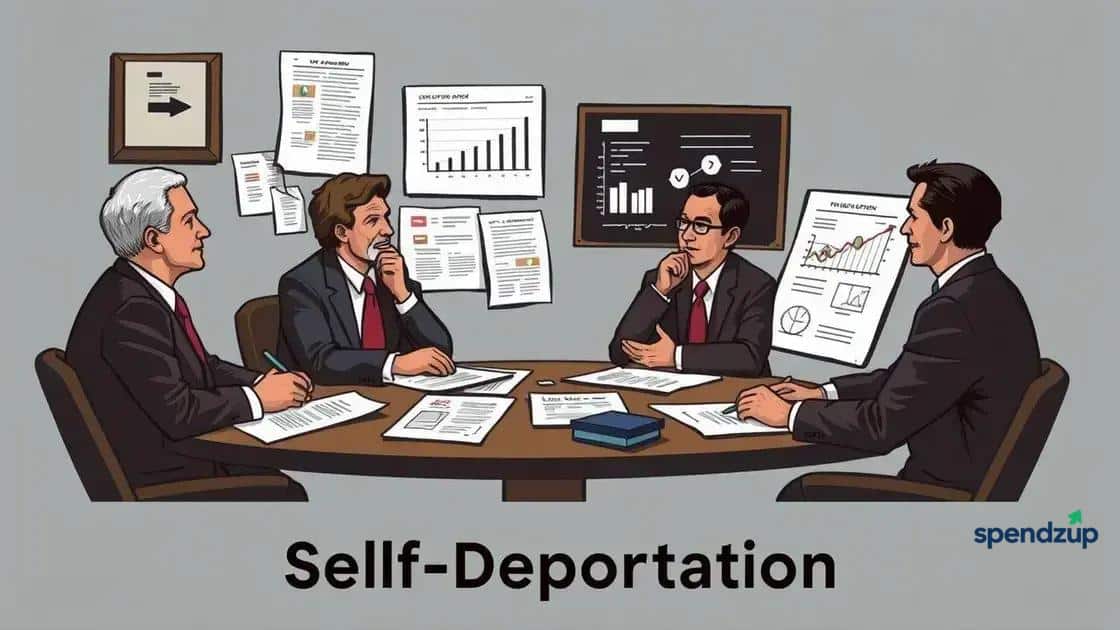Self-deportation incentives: understanding the implications

Self-deportation incentives are policies that pressure immigrants to leave a country voluntarily, often driven by fear of legal consequences and societal hostility, significantly impacting their communities.
Self-deportation incentives are rising in discussions about immigration policies. They stir curiosity about their effects on communities and individuals. Have you considered how these incentives influence the choices faced by immigrants?
What are self-deportation incentives?
Self-deportation incentives refer to the policies and factors that encourage individuals to voluntarily leave a country rather than face deportation. These incentives can create complex situations for immigrants, as they weigh their options and consider the future of their families. Understanding these incentives is essential for grasping the broader immigration landscape.
Understanding Self-Deportation
Self-deportation typically arises from a combination of legal, social, and economic factors. The fear of enforcement actions and the repercussions that follow often push people to make difficult decisions. Self-deportation can be a response to stricter immigration laws, reduced access to social services, and negative community attitudes.
Factors Influencing Self-Deportation
- Legal pressure: Increased raids and deportations can lead to a heightened sense of urgency.
- Economic downturn: Economic instability can make life harder for immigrants, pushing them to leave.
- Community support: The presence or absence of support networks may influence decisions about staying or going.
- Access to resources: Lack of access to basic needs can make remaining in a country untenable.
Additionally, many immigrants face tough choices about their status. They may aim to reunite with family members or seek better opportunities elsewhere. These decisions are often not straightforward, and they can have long-lasting implications for their lives and futures.
As such, the reasons behind self-deportation are not just personal; they reflect the policies and societal attitudes toward immigrants. These policies can create an environment where the most viable option for many is to leave voluntarily, often after considering the consequences for themselves and their families.
By delving into the various aspects of self-deportation incentives, we can gain insights into how they shape the experiences of countless immigrants and influence immigration trends.
Historical context of self-deportation

The historical context of self-deportation reveals much about how immigration policies have evolved over time. Understanding this history provides valuable insights into the modern-day implications for immigrants. Throughout different periods, various factors have influenced the decisions of individuals to self-deport, often under immense pressure.
Early Immigration Policies
In the early 20th century, the United States saw significant waves of immigration. Policies were often inconsistent and charged with racial and economic motives. Economic hardship during the Great Depression, for instance, led many immigrants to leave as jobs became scarce. The fear of deportation drove some to leave voluntarily to avoid facing the consequences of stricter enforcement measures.
Impact of Legislation
- The Immigration Act of 1965 changed the immigration landscape significantly.
- Post-9/11 policies heightened security and enforcement, creating a climate of fear.
- Legislative moments such as the passage of the Illegal Immigration Reform and Immigrant Responsibility Act of 1996 increased the stakes for undocumented immigrants.
- Seeking safety or better opportunities, many have opted to self-deport rather than face legal repercussions.
During various economic crises and changes in political climates, immigrants often found themselves in precarious situations. The societal attitude toward immigration has shifted, creating periods where self-deportation was seen as a viable option. As communities became more hostile or resources dwindled, many chose to leave their homes to seek safer environments.
Reflecting on the historical context of self-deportation helps illuminate why so many immigrants feel compelled to make these choices. Understanding the historical backdrop can inspire dialogue about more humane immigration policies that consider the challenges faced by these individuals.
Effects on immigrant communities
The effects on immigrant communities due to self-deportation incentives are profound and multifaceted. These communities often face the ramifications of such policies, which can lead to increased anxiety and instability. As individuals weigh their options, communities at large feel the ripple effects of self-deportation.
Psychological Impact
The fear of deportation creates immense stress. Many immigrants feel they must constantly look over their shoulders, leading to mental health issues. Families are often torn apart, which can disrupt social structures and create a sense of loss within communities.
Economic Consequences
- Loss of workforce: When individuals choose to self-deport, communities may lose valuable workers.
- Economic decline: Fewer immigrants can lead to reduced business activity, affecting local economies.
- Increased poverty: With less stable economic situations, remaining community members may face increased financial challenges.
- Impact on local services: Schools and health services may experience changes in funding and demand.
Beyond these immediate effects, the long-term consequences shape the very fabric of immigrant communities. Institutions may struggle to adapt to the changing demographics as families leave. Self-deportation can also influence the social cohesion within communities as support networks weaken due to the departing members.
Additionally, the sense of community identity can shift, particularly if larger groups choose to leave. Newcomers may fill the gaps left behind, but they often face their challenges in integrating and establishing roots in these communities.
As we examine the effects on immigrant communities, it’s clear that self-deportation not only impacts individual lives but also reshapes entire neighborhoods and cultural landscapes. Policies that drive self-deportation have far-reaching consequences that can echo through future generations.
Policy analysis of self-deportation

Policy analysis of self-deportation involves evaluating the laws and regulations that drive individuals to leave voluntarily. Understanding these policies is crucial for grasping the broader immigration landscape. Many of these laws are designed with specific enforcement goals that can lead to unintended consequences for immigrant communities.
Key Policies and Their Impacts
Several policies have shaped the environment for immigrants in recent years. For example, the implementation of strict immigration laws often leads to heightened fear among immigrants. Policies such as mandatory detention and family separation have created an atmosphere where self-deportation becomes a more appealing option than facing legal repercussions.
Economic and Social Considerations
- Economic stress: Policies that limit access to jobs or services can push immigrants toward self-deportation.
- Social dislocation: Families often feel the pressure of uprooting due to community sentiments against immigration.
- Resource scarcity: As immigrants self-deport, local economies may suffer from a diminished workforce.
- Long-term effects: The legacy of these policies can affect future immigration patterns and community stability.
Moreover, public sentiment plays a significant role in shaping these policies. Politicians often respond to public opinion, which can swing between support for more inclusive policies and calls for stricter measures. Some regions exhibit progressive policies that aim to support immigrants, while others yield to pressure and adopt more punitive approaches.
Analyzing these trends helps shed light on how self-deportation is viewed within the context of immigration reform. Policymakers must consider the human impact of their decisions, as each choice carries weight and consequences for individuals and communities alike.
Ultimately, understanding the intricacies of self-deportation policies can foster more informed discussions about humane approaches to immigration reform. By focusing on the real-life outcomes of these policies, stakeholders can work towards solutions that support both communities and individual rights.
Public perception and societal impact
Public perception and societal impact regarding self-deportation are crucial factors that influence immigration policy and community dynamics. How society views immigrants significantly shapes their experiences. Fear and prejudice can lead to increased pressures on individuals to consider self-deportation.
The Role of Media
Media portrayal plays a pivotal role in shaping public opinion. News stories often highlight negative stereotypes, which can amplify fears about immigration. This can create an environment where some citizens feel justified in their anti-immigrant sentiments, further marginalizing immigrant communities.
Community Reactions
- Increased hostility: A rise in negative perceptions can lead to hostility towards immigrant communities.
- Social isolation: Immigrants may feel isolated as they grapple with societal rejection.
- Community activism: Conversely, some citizens advocate for immigrant rights, creating a divided response.
- Impact on public services: Negative perceptions can influence how resources are allocated to communities, often leaving immigrant groups underserved.
Such societal impacts can result in a cycle of fear and withdrawal for immigrants. Many individuals may opt to self-deport rather than face discrimination or violence. Increased societal pressures can lead families to make difficult decisions about their futures. As communities become polarized, some immigrant families feel the urgency to leave, fearing a hostile environment.
On the flip side, grassroots movements have emerged from positive perceptions, advocating for inclusivity and understanding. These movements highlight the contributions of immigrants, fostering cultural exchange and shared experiences. Such initiatives can help diminish stereotypes and promote a more comprehensive understanding of immigration in society.
To truly address the public perception and societal impact, it is vital to bridge the gap between communities. Open dialogue can foster understanding and help dispel myths surrounding immigration, ultimately creating a more supportive environment for all.
In summary, understanding self-deportation incentives is essential
Self-deportation incentives significantly impact immigrant communities, shaping their everyday lives and decisions. These policies can create fear, leading many individuals to consider leaving voluntarily.
As we have seen, public perception plays a crucial role in shaping the societal impact of immigration policies. Understanding these dynamics can help foster discussions about creating a more inclusive environment for everyone.
Ultimately, addressing the challenges faced by immigrants requires empathy and open dialogue. By working together, we can build stronger communities where all individuals feel valued and supported.
FAQ – Frequently Asked Questions about Self-Deportation Incentives
What are self-deportation incentives?
Self-deportation incentives are laws and policies that encourage individuals to leave a country voluntarily due to fear of legal consequences or hostile environments.
How do self-deportation policies affect immigrant communities?
These policies can create anxiety, insecurity, and economic challenges within immigrant communities, often leading families to make difficult choices about their future.
What role does public perception play in immigration policies?
Public perception shapes how policies are formed and can influence societal attitudes toward immigrants, either increasing support for inclusivity or promoting hostility.
Are there positive efforts to support immigrant communities?
Yes, grassroots movements and community advocacy strive to promote understanding and inclusivity, showcasing the valuable contributions of immigrants to society.





